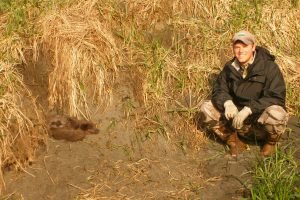
Kris Pope got the opportunity to do something many of us trappers dream of. One summer, he worked as a government trapper removing foxes on one of the Aleutian Islands in Alaska. Kris is now a forester in Georgia, an avid trapper, and founder of Coyote Trapping School, a video course program designed to teach you how to trap coyotes from the ground up. Find more about Kris and his course at www.coyotetrappingschool.com. He’s offering a generous discount to Trapping Today readers if you use the coupon code ‘today’ when you purchase the course.
Here’s Kris’s story.
The Aleutian Experience
Have you ever thought about how big the ocean is? I found myself thinking this very thought last summer while drifting in the northern Pacific. I was stranded, on a deserted island, with a 15’ inflatable dingy. The only thing between me and the other end of the world was Hawaii. Let me tell you, that can quickly humble the biggest man.
But the situation wasn’t quite so dire. I was purposely stranded, along with two other trappers, on this tiny island in the Aleutian Chain. Our mission was eradication. We were government trappers, contracted by the U.S. Fish and Wildlife Service, to remove every non-native arctic fox on the island.
History
Rootok Island, the island we were trapping, is relatively close to the Alaskan peninsula compared to the rest of the Aleutian Islands. It, along with some 2500 other islands, makes up the Alaska Maritime National Wildlife Refuge (AMNWR). This refuge is considered the largest seabird nesting ground in the world, and since there are no trees in the Aleutians the birds nest on the ground. These seabirds, all 40 million of them, are the only wildlife native to these islands, aside from the seals, sea lions, and sea otters.
When the Russians discovered the Aleutian islands in the 1700’s they saw dollar signs. You could make a handsome living in those days selling fur. Fox pelts were selling for unimaginable prices, and the Ruskies had a pretty clever trick up their sleeve. They knew that under ideal conditions a good breeding pair of foxes could produce many litters in a fairly short amount of time. And how much more ideal could the conditions get than in the Aleutians.
They could introduce several foxes to an island, depending on its size, there was no way the foxes could escape, no one would steal them, virtually no predators save the occasional eagle, excellent weather for producing prime coats, and a seemingly endless supply of food. It was such a grand idea that they introduced foxes, either arctic or red, onto almost every island in the Aleutian chain. They could then return several years later, drop a trapper off for the winter, and have a fine set of pelts to sell, and the cycle would start over again.
The islands were used for fox farming up until World War II. Then the market fell out and there was little interest in fox farming the Aleutians. By this time the foxes had lived on the islands long enough to devastate the seabird populations. Many islands were no longer inhabited at all by seabirds, and some species, like the Aleutian Canada goose, were nearly driven to extinction.
Fortunately for the foxes the ocean provides its own bounty of dead fish, and the occasional sea lion or whale that washes ashore.
Enter the Otter
In 1949 the manager of the refuge, Bob “Sea Otter” Jones, devised a plan to bring the seabirds back. The USFWS began, island by island, removing foxes in hopes of encouraging the seabirds to return. And this is the reason we are on this 5 square mile island.
Having never been to the Aleutians, I wasn’t sure what to expect. I lived in Prince William Sound one summer, and it was cool and rainy, so I expected similar conditions. There is one element that you can always count on in the Aleutians, wind, there is nothing to block it and it keeps on coming. That was the hardest thing for me to get used to, coming from the southeast where we have trees to block the wind.
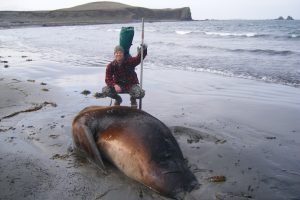
We were dropped off on the island by the Fish and Wildlife Service’s research vessel the Tiglax. We had two months worth of food, about 80 boxes, around 100 gallons of gasoline for the zodiac, 6 outboard motors, several hundred traps, and a whole heap of other gear we had to lug up the beach above the high tide line, in a drizzling rain-which turned out to be the norm. We roughly got our camp set up and spent one last day on the ship circling the island setting traps on the beaches.
We focused our efforts on the beaches because, without the nesting birds, there is nothing for the foxes to eat except for what washes up on shore, and when you walked the shoreline you rarely found any carrion. Because of the cliffs, reefs, and rocks our main mode of transportation was a 15’ inflatable zodiac with a 20 horse motor on the back. We would eyeball a likely looking section of beach to find a safe jumping off point. Typically with the surf there was no landing, we would do a “bump and run.” We would find a rock that stuck out deep enough that you could safely run the motor, and that provided a safe, relatively at least, route to the shore. We would “bump” said rock, using the motor to hold the boat there long enough for the trappers to scramble off, then kick it into reverse and maneuver safely to deeper, less rocky waters. This was quite a tricky maneuver because your landing had to be timed with a lull in the waves or else you would wind up on the beach or in the rocks.
The Elusive Foxes
We had a lot of misconceptions about our adventure, mainly because we had never been to the area or dealt with the species before. We expected to catch a good number of foxes, being as how they had never been messed with, and we also expected it to be somewhat of a challenge. I know our foxes in Georgia can be pretty elusive, so we expected to have to work for our catches. It turned out that trapping these foxes was more like trapping raccoons. I don’t know if it was a result of lack of human interaction, years of inbreeding, or that they were just that hungry but I was ashamed to call some of those sets fox sets. You really had to throw conventional trapping knowledge out the window, at least in regards to canine trapping.
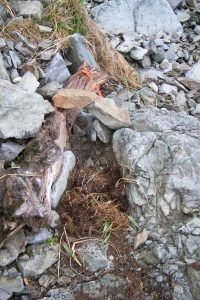
The typical Aleutian island fox set consists of two large pieces of drift wood, some grass, lure, and a staple. First you make a V with the driftwood, then staple the trap chain to one piece as a drag. Next you would “bed” the trap, and I use the term bed very loosely because it is hard to get a solid bed on a pure rock beach. In reality getting a solidly bedded trap wasn’t vital, as long as you have a smell there the foxes will come. But for my own sanity, and so I didn’t get sloppy when I returned home and set traps for typical foxes, I bedded my traps as best as I could. Some dried grass covering the trap, which was really more to deter birds than anything, a dab of lure in the back of the V and you were done. The foxes would investigate any smells, especially food smells, on the beaches, so as long as you had a set trap and some lure you stood a chance of catching a fox.
There was no consideration at all for scent control. We took traps right out of the box and set them with our bare hands. The only reason we would use gloves was because our hands were cold.
Once we got all of the beaches set we started setting the interior of the island. Another misconception we had was that we could easily cover our “small” 2 by 3 mile island in a couple of days. Well, if it had been flat we probably wouldn’t have had a problem with this, but there was nothing flat about this island, it was either up or down. There were ridges on the north and south of the island, and a ridge connecting the two, creating two big basins, one east and one west.
We started setting in the east basin where we were camped, although there was a serious lack of sign anywhere. We then moved to the ridges and got them set up. There was a good trail running the edge of the ridge, which is where the land dropped off sharply to the water. The trail wasn’t just smoking with sign, undoubtedly it had been worn down over the past 200 years and had become a near permanent mark on the landscape.
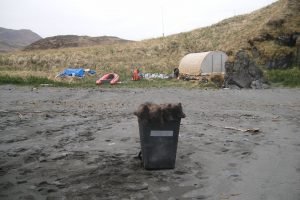
Between our excursions on foot we would make a check of our beach trap line as often as the weather would permit. It generally took two days, one for the north beach and one for the south beach. The weather wasn’t always favorable, though, as we had more than our share of days when the waves crashing on our beach would be over head height. But on the days when we did get a break it was quite an experience. We saw whales, sea lions, seals, all kinds of sea birds, we even managed to catch a few fish.
We caught the bulk of our foxes on the beaches, 17 of the 19 total, and 15 of those came in the first week. We were off to an excellent start, although completing the bulk of the goal in the first week of an eight week trip was somewhat of a letdown. But as an old nuisance trapper once told me, success is boring.
The Elements
As with much of Alaska weather is your biggest competition. If you can contend with it then you can prevail. But make no mistake about it, it will try you. As I said earlier, wind is ever present, and I’m not talking about a breeze. In certain places, especially on those cliffs over the beaches, the wind would blow so hard it was a chore to stand up.
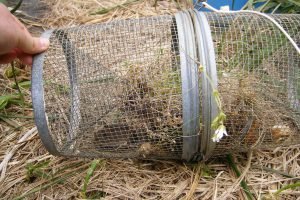
Moisture is another common condition. We rarely got any heavy rain, but an all day drizzle was a frequent occurrence, as was fog. And that fog could roll in on a moment’s notice. You’d think it would be hard to get lost on a six square mile island that is as wide open as the prairie, but it can be done. One day while my partner Mark and I were checking traps along the northern ridge a fog bank rolled in on us. Our vision was restricted to 30 yards or less, and somewhere along the way we lost our line. We wandered around for several hours, not only contending with the fog but also a stiff 30 mph wind. Let me tell you, you spend too long in those conditions and it can make a grown man want to cry. We found out that day that little island can whip you if it wants to.
We finally found the lip of the east basin where our camp was. Once we dropped off the ridge we were out of the fog and had no problem making it back to camp. After that we waited until the fog lifted to check that line again.
Success Story
The ideal ending for our trip, according to FWS guidelines, was for us to go a minimum of three weeks without catching a fox or seeing any sign. This we accomplished without any problem, so we were confident we had rid the island of any and all arctic foxes. This same scenario has played out on over 40 islands since 1949 when the fox eradication program was started. And it wouldn’t be continued if there weren’t positive results following the fox trapping.
There are many small satellite islands around the larger islands. These islands were usually too small and inaccessible for fox introduction, so the seabirds continued to thrive on these isolated islands. Once the foxes were successfully removed from an island these birds were effective at recolonizing the larger islands.
The biggest success story, and one of the major influences in continuing the trapping, is the Aleutian Cackling Goose; a subspecies of the Canada goose that is endemic to the Aleutian Islands, and was nearly driven to extinction by the foxes. Through removal of foxes and relocation of geese the population has rebounded significantly. This is a prime example of how trapping is an effective wildlife management tool and has positive impacts.
The Experience
My time in the Aleutians is something that I will never forget. It was a once in a lifetime experience and I saw things that most people only see on tv. It wasn’t all enjoyable, but every minute is what made the trip. When I finally got off the island and out of the Aleutians I vowed I would never go back, then my buddy Mark told me the following spring he was going back to trap another island. I didn’t think I would get jealous of someone going to that god forsaken land, but oh, how I wanted to go back. If you’ve never been there it may be hard to understand, but those who have know there is something about Alaska that gets in your blood. You can’t get rid of it and you’ll always want to return. I know I’ll be back again.
Leave a Reply